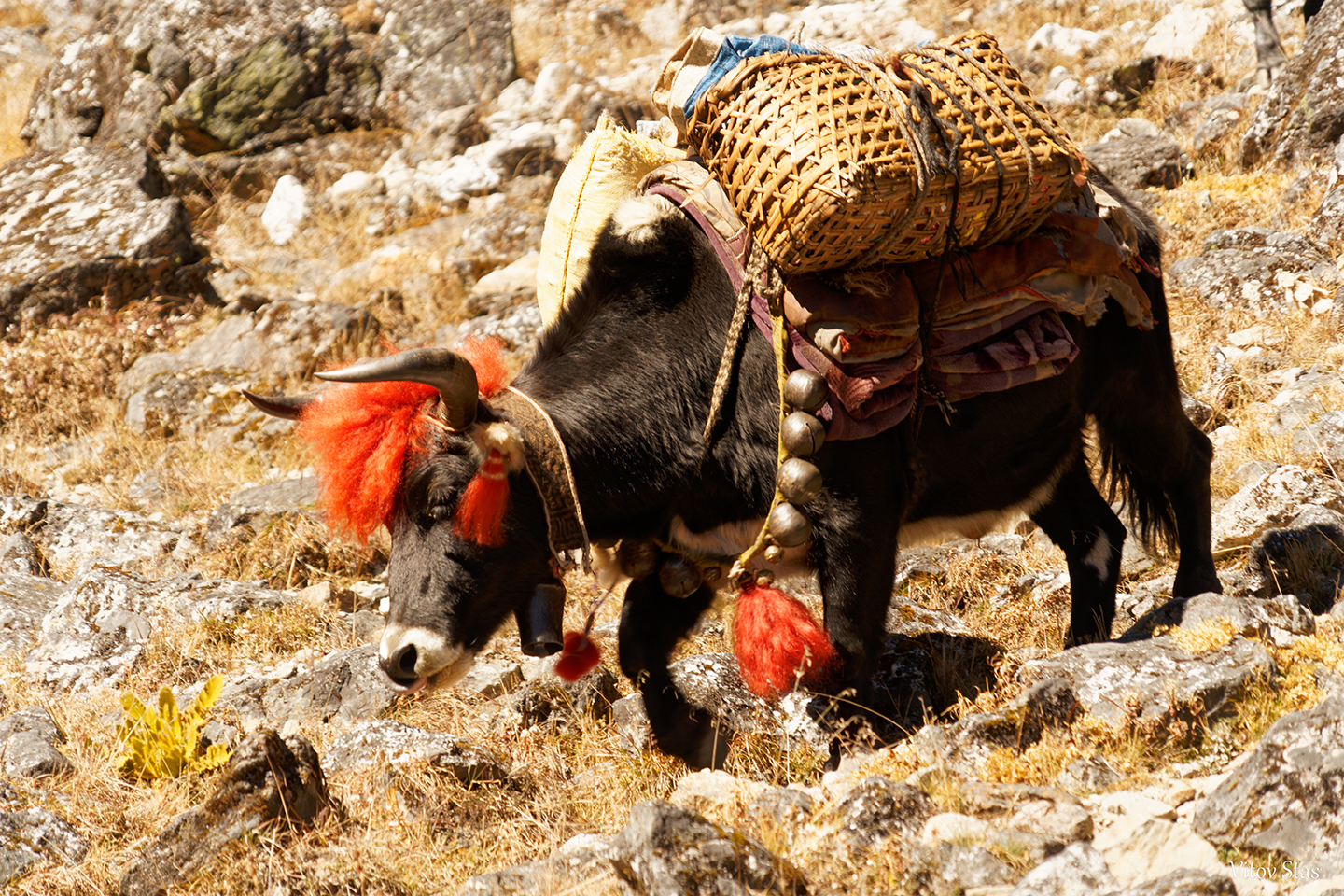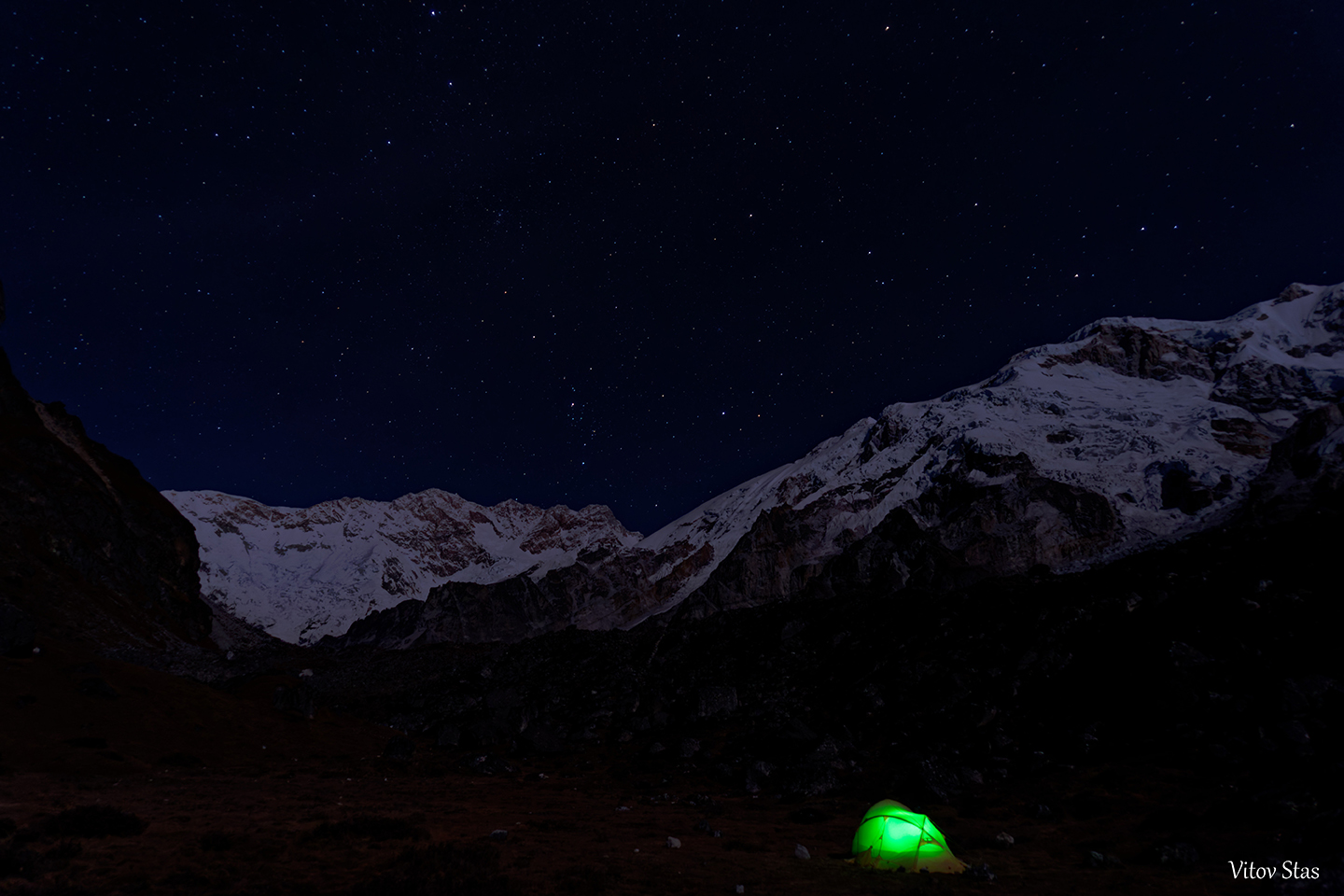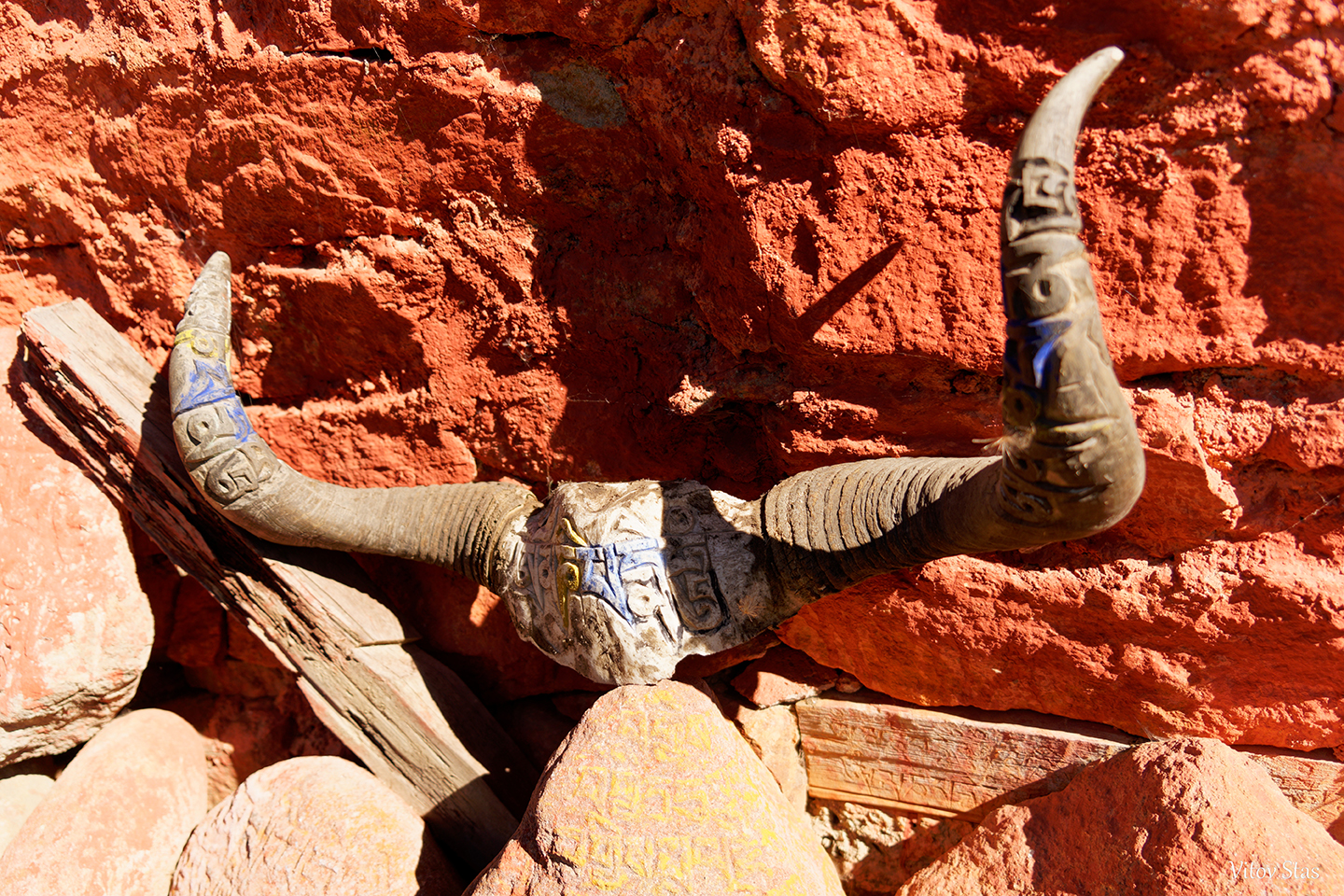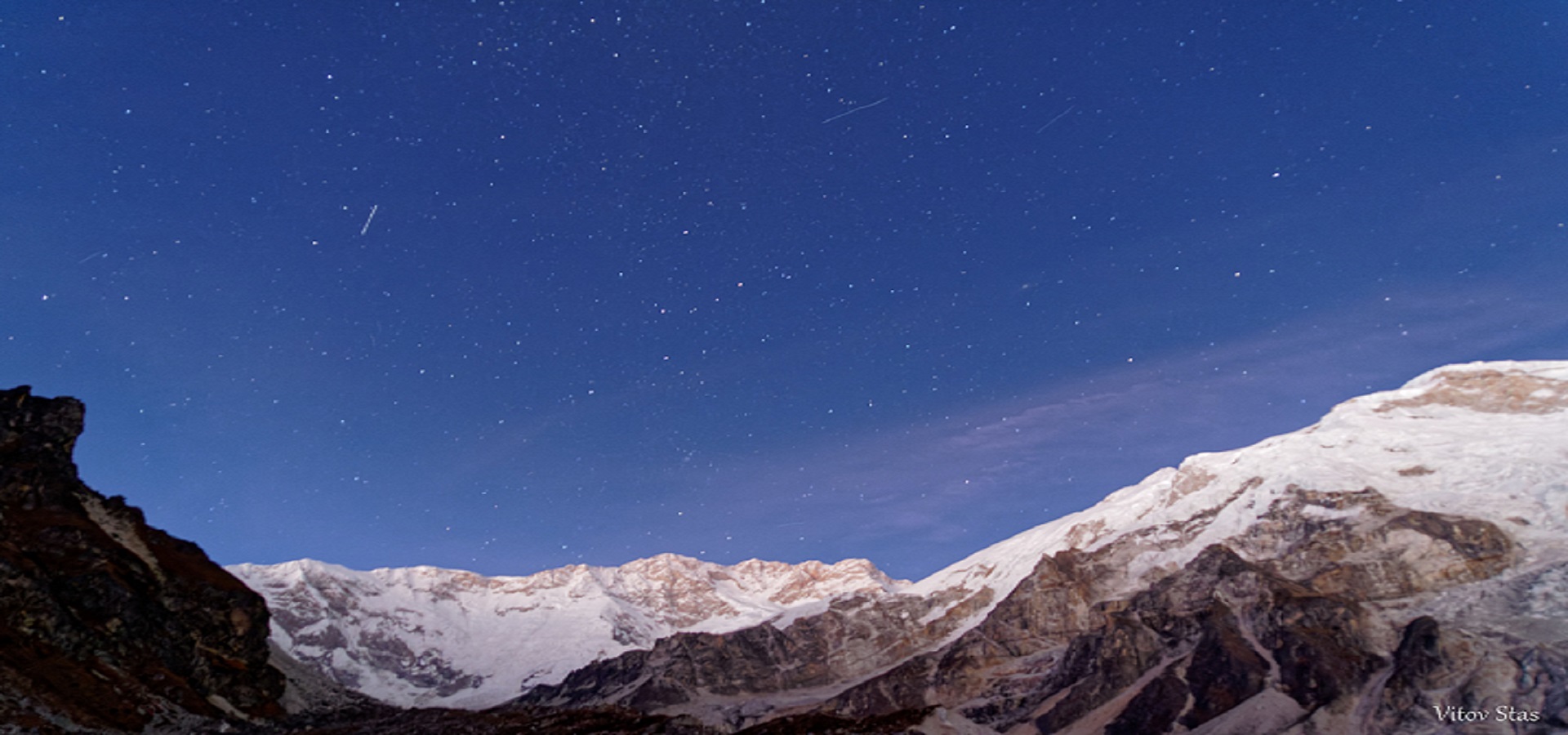
KANCHENJUNGA HIMAL TREK
- Home /
- Nepal /
- Trekking & Hiking /
- Kanchenjungd Region /
- KANCHENJUNGA HIMAL TREK
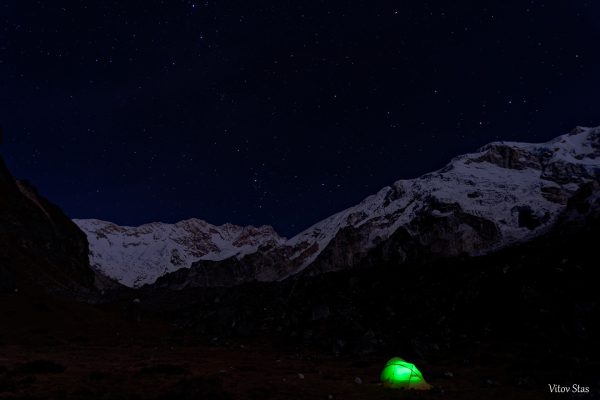
The great massif of Kanchenjunga, lying in the far east of Nepal on the boarder with Sikkim, is the second highest mountain in Nepal, the third highest in the world. This outstanding trekking region offers the fit walkers a chance to experience the stunning contrasts of Nepal – from the dusty, lowland plains of Terai to the high alpine ridges adjacent to many of the greatest peaks of the world.
We fly east from Kathmandu to Bhadrapur with our first views of Kanchenjunga (8,598m), Jannu (7,710m), Makalu (8,481m) and Everest (8,848m). From Bhadrapur we drive by a Jeep to Taplejung passing through the beautiful Tea Garden of Nepal via Ilam.
Mount Kanchenjunga is the third-highest mountain in the world at an altitude of 8,586m. The summit was first climbed in 1955 by Joe Brown and George Band in a team of British mountaineers. In 1977 an Indian Army team made the second ascent on the northeast ridge from Sikkim on the Indian side.
Above the tree lines the views become more dramatic as we travel to the northern base camp – Pangpema, with the mighty north face of the mountain dominating all. On the way to Pangpema we cross a series of high passes as we move to the east – with their stunning views and will bring us to Tseram. The views on the trek are incredible: Kanchenjunga (8586m), Kambachen (7903m), Pyramid Peak (7123m), Tent Peak (7365m), Yalung Kang (8505m). This is one of the best treks available in Nepal: for those seeking a challenge, this walk is surely going to be a classic.
Itinerary In Detail
-
1: Arrival in Kathmandu (1,400 m / 4,592 ft.)
Upon arrival in Katmandu’s Tribhuvan International Airport, meet, assist and transfer to hotel. After welcome refreshments and room check in the hotel, there will be a short briefing and orientation about the trip. Rest of the day is free for leisure.
Overnight at hotel.
-
2: Trek preparation and special permit processing day in Kathmandu.
Spend a day in Kathmandu for last minute trek preparations. Meanwhile we will apply and obtain your special trekking permit for Kanchanjunga from Department of Immigration.
Overnight at hotel.
-
3: Fly to Bhadrapur and drive to Ilam (1,677 m / 5,500 ft.)
After early breakfast transfer to Kathmandu’s Domestic airport to board the 50-minute scenic flight to Bhadrapur. Upon arrival meet assist and start drive to Ilam.
Ilam is Nepal’s largest tea plantation area and serves as a major tourist area even for domestic tourists. The picturesque town of Ilam hosts large orchards of tea plants and is also famous for the Himalayan chew made of cheese.
Dinner and overnight at hotel.
-
4: Drive to Taplejung (1,820 m / 5,970 ft.) – 5~6 hrs.
After breakfast, continue drive towards Taplejung. Driving along the beautiful countryside view, we pass through Phidim to reach Limbu village of Taplejung. Overnight in Taplejung.
Dinner and overnight at hotel.
-
5: Drive to Ranipul & start short trek to Amjilosa – 2,510 / 8,232 ft. – 6~7 hrs.
After breakfast, get into the 4WD vehicle and start drive to Ranipul, drive is mostly through the unpaved Mountain Road. In Ranipul we will meet our trekking support team, after the short preparation we will walk to Amjisola. Rest of the day is for free.
Dinner and overnight at teahouse
-
6: Trek to Gyabla (2,730 m / 8,954 ft.) – 5~6 hrs
Today, we walk through forested trail filled with rhododendrons, Oak and bamboo, before ascending to Gyabla. We also come across a big waterfall on the opposite side of the river on our way to Gyabla. Most of the people we see them are Tibetan tribes
While on a trek we can see yaks and sheep on the trail. After lunch trail takes us up through dense forest cover and over a wooden bridge on to Gyabla.
Overnight at Teahouse Lodge.
-
7: Trek to Ghunsa (3,595 m / 11,791 ft.) – 6~7 hrs
Leaving behind the beautiful Gyabla village, we trek towards Ghunsa through a broad meadow. We then climb a small hill and descend to cross the river to reach the Tibetan village of Ghunsa with wooden houses, a micro hydropower plant, school, and a health post.
Overnight at Teahouse Lodge.
-
8: Rest Day in Ghunsa for acclimatization.
We spend an additional day in Ghunsa for acclimatization before we ascent further high. After relaxing morning, take a short hike to the opposite side of Ghunsa Khola (River), we gain certain height and return back to lodge for lunch. Rest of the day is for rest.
Overnight at Teahouse Lodge.
-
9: Trek to Kambachen (4,100 m / 13,448 ft.) -5~6 hrs
Views of the Jannu Himal dominate the skyline today. Following a gentle upwards path, we come to a green glacier valley. Here we may be lucky to spot blue sheep and snow leopards. The trail continues on past a waterfall to a landslide-prone area where we take particular care.
Kambachen has a Tibetan settlement from where one can get the stunning view of the north face of Jannu (7,710 m / 25,288 ft.)
Dinner and overnight at teahouse lodge.
-
10: Rest & acclimatization in Kambachen.
Spend a rest day in Kambachen for acclimatization, we will go on a short hike near by to gain some elevation return back for rest.
Dinner and overnight at teahouse lodge.
-
11: Trek to Lhonak (4,785 m / 15,694 ft.) – 7~8 hours.
Today the trail takes us mainly over moraine from the Kanchenjunga Glacier. Walking uphill over large boulders there are wonderful views on both sides of us.
And as we are deep in Snow Leopard territory, we keep our eyes open for this rare animal too! This is also an area of summer yak pastures but there are no settlements on the route. From Lhonak, one can witness the panoramic view of massive mountain peaks like Wegde Peak (6802m), Mera Peak (6364m), Nepal Peak (7177m), Twins (7350m), and many others.
Dinner and overnight at teahouse lodge.
-
12: Day trip to Kanchanjunga North Base Camp (5,143m / 16,870 ft.) -8~9 hours.
Today, we head towards Kanchenjunga Base Camp following the trail along the glaciers on the northern ridges. The camp is also known as Pang Pema from where we get the mesmerizing and spectacular view of Mt Kanchenjunga (8,586m) along with the skyline filled with snow-capped mountain ranges bordering Nepal-India and Nepal-Tibet. After exploring the Kanchanjunga Base Camp return back to Lonak.
Dinner and overnight at teahouse lodge.
-
13: Backtrack to Ghunsa – 7~8 hrs.
Back track to Ghunsa.
Dinner and overnight at teahouse lodge.
-
14: Trek to Sele le (4,390m / 14,400 ft.) – 6~7 hrs.
Today we trek along a steep rocky trail through a forested area filled with birch, pine, and colorful rhododendron. An amazing view of Jannu (7710m), Nyukla Laching (6670m), Temachunggi (6044m), and other mountains.
Dinner and overnight at teahouse lodge.
-
15: Trek to Theram (3,870 m / 12,693 ft.) -8~9 hrs.
Today might be the most challenging day as we cross over two passes on our way to Tseram, the highest pass being the Sele La (4480m) and Sinion La (4660). Upon reaching the top of the passes, we are rewarded with an amazing view of Yalung Glacier, Jannu (7,710m), Makalu (8481m), Baruntse (7,129m), Kanchenjunga (8,586m), and many other mountain ranges along the Sikkim border. We then descend to Tseram.
Dinner and overnight at teahouse lodge.
-
16: Day trip to Kanchanjunga South Base Camp via Ramche (4,580 m / 15,022 ft.) – 8~9 hrs.
Passing the moraines of Yalung Glacier into an ablation valley, we ascend towards Ramche. We also come across a lake and a meadow where we can spot the blue sheep grazing on the grassy hills.
In the noon explore Yalung Base Camp (4,500 m / 14,760 ft.), the trial to Yalung is throug the glacial moraines and challenging rocky path, we cross Oktang, from where we can get a panoramic view of Jannu (7720m) and Kanchenjunga (8586m), and several other peaks. We return back to Ramche for an overnight stay.
Dinner and overnight at teahouse lodge.
-
17: Trek to Torongding (2,080 m / 6,822 ft.)
Today the trail is mostly downhill through a gorge. But the final section is a steep uphill over an area prone to landslides and through forests. There are no settlements until we reach Torongding, where there are a few teahouses.
Dinner and overnight at teahouse lodge.
-
18: Trek to Ranipul (2,510 m / 8,232 ft.) – 7~8 hrs.
The walking is easier now we are back at a lower altitude. We find interesting villages and terraced fields on our route. We continue on to Khebang where we stay the night.
Dinner and overnight at teahouse lodge.
-
19: Drive to Ilam via Taplayjung – 8~9 hrs.
After early breakfast, drive to Taplayjung by 4WD vehicle. After arrival in Taplayjung switch into another vehicle and continue drive to Illam. En-route we will stop for lunch.
Dinner and overnight at hotel.
-
20: Drive back to Bhadrapur and fly to Kathmandu.
After breakfast, start scenic drive to Bhadrapur to board the evening flight to Kathmandu. Upon arrival Kathmandu, transfer to hotel for room check in and rest.
Dinner and overnight at hotel.
-
21: Contingency day.
Spend a free day in Kathmandu.
Overnight at hotel.
-
22: Final departure from Kathmandu.
Free until final departure transfer to Kathmandu’s International Airport.
22 Days From
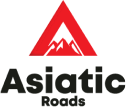
Any Question?
Feel free to call our travel experts.
+977 9851189018, +977 9801089018
info@asiaticroads.com
Accomodations
Accomodation (Hotels envisaged or similar)
| Kathmandu | Hotel | 2 | BB |
|---|---|---|---|
| ILLam | Hotel | 1 | BB |
| Taplejung | Hotel | 1 | BB |
| Amjilosa | Tea House/Camping | 1 | FB |
| Gyabla | Tea House/Camping | 1 | FB |
| Ghunsa | Tea House/Camping | 2 | FB |
| Kambachen | Tea House/Camping | 2 | FB |
| Lhonak | Tea House/Camping | 2 | FB |
| Ghunsa | Tea House/Camping | 1 | FB |
| Sele le | Tea House/Camping | 1 | FB |
| Therom | Tea House/Camping | 2 | FB |
| Torongding | Tea House/Camping | 1 | FB |
| Ranipul | Tea House/Camping | 1 | FB |
| Tapalayjung | Hotel | 1 | BB |
| Bandrapur | Hotel | 1 | BB |
| Kathmandu | Hotel | 1 | BB |
22 Days From

Any Question?
Feel free to call our travel experts.
+977 9851189018, +977 9801089018
info@asiaticroads.com
Additional Information
-
Clothing & Equipments
WHAT TO WEAR:
Light clothing is only for short treks up to seven days at altitudes up to 6000ft (1830m) during fall (autumn) from September to November and in spring between March to May. The other months at all altitudes will be cold and at most times the temperatures will be below zero.
Footwear:
You will need hiking boots with ankle support, sneakers for flat trails, and flip-flops or chappals for use around the camp/lodge.
Clothes:
Shirts, T-shirts (4), blouse, etc., for daywear and a woolen shirt/T-shirts for evenings.
MEN:
Shorts, cotton trousers, jeans, sweatpants (recon-mended), etc.
Undergarments & Socks:
Thermal underwear and inner trousers for the above 7,000 ft. treks. Thick trek socks.
Warm Clothes:
A light sweater, a windcheater or light lined/padded jacket, and a down jacket or parka for above 7000 ft. treks. Woolen thick cap and warm gloves.
Sun / Rain:
Rain gear or umbrella and a sun hat are essential. Global warming has led to freak weather conditions and it has become more and more difficult to predict weather conditions.
Note: Umbrellas are cheap and easily available in Kathmandu.
HOW TO PACK
In The Day Pack: In the Duffel Bag: Sunglasses Towels Moisturizing/Sunscreen lotion Spare batteries Prescribed medicines Toiletries Flashlight washing soap Camera and spare film Spare clothes all wrapped in plastic bags Binoculars-optional Reading Reference book/Notebook Pencil/Pen / Water bottles/ Trek permits Toilet paper Umbrella/rain gear / Sweater Note: Sleeping bags can be purchased in Kathmandu. It is even available on hire upon request. However, we request our clients to bring their own sleeping bags because of hygiene.
-
How To Train For Trekking
Many people worry that they are not fit enough for long treks, especially in the challenging Himalayan region. However with the right training realistic expectations, and healthy on-trail habits, Himalayan treks is possible for most of healthy hikers. Here are some tips for how to train for trekking in the Himalayas.
START EARLY
You will need to build muscle, endurance and your cardiovascular system. Do no put of training until a month before you leave. It is worth splurging a bit and hiring a trainer who can design a program specifically for what you are doing. If he or she can see you’re hiking Itinerary, even better. They will likely develop a plan that spans several months. Stick with it.
USE A COMBINATION OF EXERCISES
If you choose to develop you own plan (after careful research), use a variety of exercises. Including trail running ensures you will be confident on your feet on uneven terrain. You will also want to include box steps on boxes of varying heights while holding weights. Though you need to build strength to hike 4 to 9 or 10 hours in a day, it is also worthwhile to include sprint intervals, either running or on a bike. This improves your recovery time. Try short bursts of pushing a heavy sled to build your CV system to ensure you don’t feel like throwing up on the trail!! And do not forget your Arms! You should use your trekking poles, and these may give you more of a forearm workout tan you anticipate. Try some triceps extensions, as well as pull ups, rows and dips for your shoulders and back. You will, after all, be carrying a day pack.
STAYING HEALTHY ON TREK
Water is most important part of your hike. Drink at least 3/4 liters of water a day. Ensure yourself you are rehydrating all the time (Dehydration is one of the reason of Acute Mountain Sickness) . Stretch your calves, hips and gluteus any time you stop. This will minimize morning soreness and prevent injury. Bring bio freeze, icy hot, or Tiger Balm for rubbing on sore muscles at night (Tiger Balm is easily available in Kathmandu & Pokhara); these are practically helpful on and behind my knees after steep down hills. No matter what your diet is at your home, eat on a trail. All the teahouses serve pasta, rice, and pizza. Take an advantage of all those carbs. Avoid having alcoholic liquor especially while going up in the High Altitude.
WHEN YOU FINISH
The work you have done hiking will affect you even particularly painful, as your legs may be very restless for several days. Wear compression socks and try to get an aisle seat so you can walk around. After all this, you will definitely come away with a sense of exactly how strong your body is.
-
Notes On Acute Mountain Sickness
Key to acclimatization: Is adequate hydration, adequate nutrition & managing personal comfort through adequate layers lead to acclimatization.
Following extracts are taken from “The Wilderness First Responder” by Buck Tilton, director of Wilderness Medicine Institute of NOLS, USA
Dehydration
Without water there would be no life – at least no life, as you know it…
Water puddles inside every one of your cells, and flows through the microscopic spaces between cells. In water, oxygen and nutrients float to all parts of your body, and waste products are carried away. When your kidneys remove waste from your body those wastes have to be dissolved in water. Digestion and metabolism are water-based processes, and water is the primary lubricating element in your joints. You even need water to breathe, your lungs requiring moisture to expedite the transfer of oxygen into blood and carbon dioxide out of blood. Sweat, as mentioned, is mostly water. The water in your blood carries heat from warmer body parts to cooler areas of your anatomy when you are exposed to cold. In short, if aren’t well hydrated, you won’t be able to stay healthy, maximize your performance, or even maintain joy at being outdoors.
The water in your body, the fluid that keeps you alive and active, leaves you at an alarming rate. Estimates vary widely, but an average person at rest on a normal day loses between two and three liters of water. One to one-and-a-half liters rushes out as urine, and another one-tenth liter in defecation. Moisture is lost from act of breathing, more than half a liter per day, and that rate increases in dry winter air.
Then there’s sweat. The fluid lost in perspiration can climb to one to two liters per hour during periods of strenuous exercise. Compared to watching TV all day, one hour of exercise may demand approximately a 50 percent increase in the amount of water your body uses.
Your thirst mechanism that feeling of ”Gosh, I need a drink of water”, doesn’t kick in until you’re about one to one-and-a-half liters low. Down three to four liters can leave your endurance decreased to 50 percent and your oxygen uptake reduced close to 25 percent…
Acclimatization
The medical problems collectively referred to, as “altitude illnesses” is the result of hypoxia, insufficient oxygen in the blood for normal tissue function, a result of the decreased barometric pressure at higher altitudes. When you go up, the barometric pressure goes down, the concentration of oxygen in the air decreases, and the chance of altitude illness climbs.
Since there is a measurable increase in ventilation and decrease in aerobic exercise performance above 4,000 feet elevation, “high altitude” can be said to start at that point. Complications seldom occur, however, below 8,000 feet. In defining terms, consider 8,000 to 12,000 feet as high altitude, 12,000 to 18,000 as very high altitude, and 18,000 plus as extreme high altitude.
The human body will adjust to dramatic changes in barometric pressure, given enough time. Altitude illnesses – which range from mildly disturbing to completely fatal – are determined, primarily, by three factors:
How high the patient goes.
- How fast the patient attains a specific altitude, and
- Predisposing factors such as genetics and previous upper respiratory illnesses.
- Critical to acclimatization is adequate hydration and nutrition.
PREVENTION:
As mentioned earlier, most people will adjust to altitude given enough time. Staged ascent is the key to acclimatization and, therefore, the key to preventing altitude illnesses.
Adequate hydration is critical to the prevention of altitude illnesses. You should drink enough water to keep your urine output clear and copious.
A high calorie diet is essential for the energy needed to ascend and acclimatize.
Avoid respiratory depressants, such as sleeping pills and alcohol.
…But physical fitness prior to ascent is a bonus in the game of safety and enjoyment. Fitness does not, however, protect against acute mountain sickness.
(Friends: this is just to inform you about these important factors that we would be dealing in on the mountain. I know that there would be a lot of questions in your mind – how does one acclimatize, what food is to be taken, what are the early signs and symptoms that would alert me to start taking extra efforts to stay hydrated/acclimatized, etc. etc.)
-
Embassies In Nepal
American Embassy in Kathmandu, Nepal
Maharajgunj, Kathmandu, Nepal.
City: Kathmandu.
Phone: 00977-1-400-7200
Fax: 00977-1-400-7272
Website: http://kathmandu.usembassy.gov
Email: usembktm@state.gov, consktm@state.gov
Australian Embassy in Kathmandu, Nepal.
P.O Box 879 Bansbari.
Kathmandu, Nepal.
City: Kathmandu.
Phone: 00977-1-437 1678
Fax: 00977-1-437 1533
Website: http://www.nepal.embassy.gov.au/
Austrian Consulate in Kathmandu, Nepal.
22, Manakamana Marg.
Nagpokhari, Naxal.
Kathmandu, Nepal.
City: Kathmandu.
Phone: 00977-1-443 4648 / 443 4690 / 443 4860 / 443 4825
Fax: 00977-1-443 4515
Email: autconktm@wlink.com.np
Bangladeshi Embassy in Kathmandu, Nepal.
Naxal, Bhagawati Bahal.
G.P.O. Box: 789
City: Kathmandu
Phone: 00977-1-4414943 / 4414265
Belgian Consulate in Kathmandu, Nepal.
Bhagawan Bahal, Thamal.
Amrit Marg 643/26.
City: Kathmandu.
Phone: 00977-1-4413732
Fax: 00977-1-4410330
Email: diplobel@wlink.com.np
British Embassy in Kathmandu, Nepal.
P.O. Box 106
Lainchaur.
Kathmandu, Nepal.
City: Kathmandu
Phone: 00977-1-4410583 / 4414588
Fax: 00977-1-4411789 / 4416723
Website: http://ukinnepal.fco.gov.uk/en/about-us/our-embassy/contact-us/
Email: britemb@wlink.com.np
Office Hours: Monday to Thursday 0815- 1230/1330-1700hrs Friday 0815- 1315hrs Consular Section: Monday to Thursday 0815-1230hrs Friday 0815- 1315hrs
Canadian Consulate in Kathmandu, Nepal.
C/O: Canadian Cooperation Office, Lazimpat.
Kathmandu, Nepal.
City: Kathmandu
Phone: 00977-1-4415193 / 4415389 / 4415291 / 4415861
Fax: 00977-1-4410422
Email: cco@canadanepal.org
Chinese Embassy in Kathmandu, Nepal.
Baluwater.
Kathmandu, Nepal.
City: Kathmandu.
Phone: 00977-1-4411740
Fax: 00977-1-4414045
Email: chinaemb_np@mfa.gov.cn
Honorary Consulate of the Republic of Cyprus in Kathmandu, Nepal.
Jyoti Bhawan, Kantipath,
P.O. Box Nr 133,
Kathmandu, Nepal.
City: Kathmandu.
Phone: 0077-1-4225490 / 4226327
Fax: 00977-1-4226314
Email: pjyoti@mail.com.np
Danish Embassy in Kathmandu, Nepal.
761, Neel Saraswati Marg.
P.O. Box: 6332.
Lazimpat, Kathmandu, Nepal.
City: Kathmandu.
Phone: +977 1 413 010
Fax: +977 1 411 409
Website: http://www.ambkathmandu.um.dk
Email: ktmamb@um.dk
Office Hours: Monday to Thursday: 10:00 am to 1:00 pm Friday: 10:00 am to 1:00 pm
Egyptian Embassy in Kathmandu, Nepal.
Pulchowk, Lalitpur.
City: Kathmandu.
Phone: 00977-1-5524812 / 5520083 / Dir. 5544468
Fax: 00977-1-5522975
Finnish Embassy in Kathmandu, Nepal.
Bishalnagar, G.P.O. Box 2126.
City: Kathmandu.
Phone: 00977-1-4417221 / 4416 636
Fax: 00977-1–4416703
Website: http://www.finland.org.np/
Email: sanomat.kat@formin.fi
Office Hours: Customer Service: Mon-Fri 8.30-16.15
French Embassy in Kathmandu, Nepal.
Lazimpat – BP 452.
City: Kathmandu.
Phone: 00977-1-4412332 / 4414734
Fax: 00977-1-4418288
Website: http://www.ambafrance-np.org/
Email: ambassade@ambafrance-np.org
German Embassy in Kathmandu, Nepal.
Gyaneshwar, Kathmandu.
P.O Box 226, Kathmandu, Nepal.
City: Kathmandu, Nepal.
Phone: 00977-1-4412786 / 4416527
Fax: 00977-1-4416899
Website: http://www.kathmandu.diplo.de
Email: info@kathmandu.diplo.de
Greek Consulate in Kathmandu, Nepal.
P.O. Box 925, Thapathali, Kathmandu, Nepal.
City: Kathmandu.
Phone: 00977-1-4222050 / 4233113
Fax: 00977-1-4261192
Email: bonne@naag.htp.com.np
Greenlandic Embassy in Kathmandu, Nepal.
761, Neel Saraswati Marg.
Lazimpat, Kathmandu.
Nepal.
City: Kathmandu.
Phone: 00977-1-4413010
Fax: 00977-1-4411409
Website: http://www.ambkathmandu.um.dk
Email: ktmamb@um.dk
Office Hours: Monday-Thursday: 10:00 am to 3:00 pm Friday: 10:00 am to 1:00 pmDetails: The Faroe Islands and Greenland are part of the Kingdom of Denmark. As a main principle, the Danish Constitution stipulates that the foreign and security interests for all parts of the Kingdom of Denmark are the responsibility of the Danish government.
Indian Embassy in Kathmandu, Nepal.
P.O. Box – 292, 336
Kapurdhara Marg.
City: Kathmandu.
Phone: 00977-1-4410900 / 4414990
Fax: 00977-1-4428279
Website: http://www.indianembassy.org.np
Email: pic@eoiktm.org
Israeli Embassy in Kathmandu, Nepal.
Bishramalaya House.
Lazimpat Street.
P.O. Box 371
Kathmandu, Nepal.
City: Kathmandu.
Phone: 00977-1-4411811 / 4413419 / 4419103
Fax: 00977-1-4413920
Website: http://kathmandu.mfa.gov.il
Email: info@kathmandu.mfa.gov.il
Office Hours: Monday to Friday: 09:00 – 12.00 hrs.
Japanese Embassy in Kathmandu, Nepal.
P.O. Box No. 264.
Panipokhari.
Kathmandu.
Nepal.
City: Kathmandu
Phone: 00977-1-4426680
Fax: 00977-1-4414101
Website: http://www.np.emb-japan.go.jp
Email: culjpn@mos.com.np
Office Hours: 09:00 to 13:00/14:30 to 17:00
Details: Closed on Saturdays, Sundays & The Embassy designated Holidays
Malaysian Embassy in Kathmandu, Nepal.
2nd Floor, Block B.
Karmachari Sanchaya Kosh Bhawan.
P.O. Box 24372 Pulchowk, Lalitpur.
Kathmandu, Nepal.
City: Kathmandu
Phone: 00977-1-5010004 / 5010005
Fax: 009771-1-5010492
Website: http://www.kln.gov.my/perwakilan/kathmandu
Email: malkatmandu@kln.gov.my
Office Hours: Work day: Monday – Friday 9.00 am – 5.00 pm Holiday : Saturday – Sunday and Public Holidays
Myanmar Embassy in Kathmandu, Nepal.
Chakupat, Patan Gate, Lalitpur P.O. Box 2437.
City: Kathmandu.
Phone: 00977-1-5521788 / 5523402
Fax: 00977-1-5523402
Email: emb@myanmar.wlink.com.np
Dutch Consulate in Kathmandu, Nepal.
Bakhundole Height, Lalitpur, Nepal.
P.O.Box: 1966
City: Kathmandu
Phone: 00977-1-5523444
Fax: 00977-1-5523155
Website: http://www.netherlandsconsulate.org.np
Email: consulate@snv.org.np
Office Hours: Monday-Friday 9:00 am – 5:00 pm
Consulate of New Zealand in Kathmandu, Nepal.
Tiger Mountain Pvt. Ltd.
Ramalaya, Panipokhari.
P. O. Box 242
City: Kathmandu.
Phone: 00977-1-4426427
Fax: 00977-1-4361600
Email: nzconsulate@tigermountain.com
Office Hours: Monday-Friday 10:00-12:00
Norwegian Embassy in Kathmandu, Nepal.
Office Address: Surya Court, Pulchowk, Lalitpur.
Postal Address: P.O. Box 20765.
City: Kathmandu
Phone: 00977-1-5545307
Fax: 00977-1-5545226
Website: http://www.norway.org.np
Email: emb.kathmandu@mfa.no
Office Hours: Monday – Thursday: 08:30 – 16:30 Friday: 08:30 – 14:00
Pakistani Embassy in Kathmandu, Nepal.
P.O. Box No.202, Pushpanjali, Maharajgunj.
Chakrapath.
City: Kathmandu.
Phone: 00977-1-4374024
Fax: 00977-1-4374012
Email: info@pakemb.org.np, pakemb@mos.com.np
Filipino Consulate in Kathmandu, Nepal.
Toyota House, Lazimpa.
P.O. Box 2640
Sinamangal, Tinkune.
City: Kathmandu
Phone: 00977-1-4474892 / 4478301
Fax: 00977-1-4471195 / 4486243
Email: voith@mos.com.np,phicongen@voith.com.np
Honorary Consulate of the Republic of Poland in Kathmandu.
Golchha House, Ganabahal,
P.O. Box 363
City: Kathmandu
Phone: 00-977-1-4249939
Fax: 00977-1-4249723
Email: namanupa@gmail.com imports@golchha.com
Russian Embassy in Kathmandu, Nepal.
P.O.Box 123, Baluwatar, Kathmandu, Nepal.
City: Kathmandu.
Phone: 00977-1-4412155 / 4411063
Fax: 00977-1-4416571
Email: ruspos@info.com.np
Slovak Consulate in Kathmandu, Nepal.
G.P.O. Box: 3664, Kathmandu, Nepal.
City: Kathmandu
Phone: 00977-1-5521730 / 5524741
Email: cdkarky@wlink.com.np
Korean Embassy in Nepal.
Jhamsikhel, Lalitpur.
Phone: 00977-1-521084 / 521855.
Sri Lankan Embassy in Kathmandu, Nepal.
P.O. Box 8802
Baluwatar.
Kathmandu.
Nepal.
City: Kathmandu
Phone: 00977-1-4419289 / 4413-623
Fax: 00977-1-4418128
Email: embassy@srilanka.info.com.np
Swedish Consulate in Kathmandu, Nepal.
Meera Home.
Khichapokhari.
Kathmandu.
Nepal.
City: Kathmandu
Phone: 00977-1-4220939 / 4221287
Fax: 00977-1-4221826
Email: meerahome@wlink.com.np
Office Hours: Monday – Friday 10.00-12.30
Thai Embassy in Kathmandu, Nepal.
167/4 Ward No. 3.
Maharajgunj-Bansbari Road.
P.O. Box. 3333
Kathmandu.
City: Kathmandu.
Phone: 00977-1-4371410 / 43711411
Fax: 00977-1-4371408 / 4371409
Website: http://www.thaiembassy.org/kathmandu
Email: thaiemb@wlink.com.np
Office Hours: Office Hours Monday – Friday- 08.30 – 12.30 hours ; 13.30 – 16.30 hours’ Consular Section (Visa)- 09.30 – 12.30 hours ; 16.00 hours (Collection of Visas)
Turkish Consulate in Kathmandu, Nepal.
Khetan’s Industry House, Bijuli Bazaar.
City: Kathmandu
Phone: 00977-01-4446400
Fax: 00977-1-5549224
Email: scaktm@wlink.com.np -
Notes For Trekkers / Travellers
Dear Guests,
Namaste & warm Greetings from Nepal!!We are very pleased that you have inquired for your trek with Asiatic Roads. The idea of this hand out is to furnish you with information for your pre-trek preparations.
Firstly, we recommend that you travel light. A good-sized duffel bag with a top length zipper that can lock is best, together with a day pack for carrying personal items on the trek. An extra smaller bag would be handy to carry back your souvenirs after the trip.
AFTER ARRIVAL IN KATHMANDU
1. TREK BRIEFING:
On your arrival in Kathmandu, we will arrange to meet for a pre-trek briefing. Full information on all aspects of your trek, questions and doubts will be discussed. On trek your Sherpa leader (sardar) will give you more details about the route, villages, people and other information regarding the trek.2. PACKING:
You may leave behind part of your luggage in your hotel or our locker room before the trek, in Kathmandu. All baggage is to be clearly marked and locked. Kindly refrain from carrying or wearing valuables on the trek. You may leave them behind at the safety deposit box at your hotel or with us.3. HOW TO PACK:
Your clothes and equipment should fall into the following 4 categories:1. What you are going to leave behind in Kathmandu.
2. What you are going to wear on the trail.
3. What you are going to carry in your day pack.
4. What you would like the porters to carry for you.Excess clothes and luggage can be stored in your hotel’s storeroom, and valuables in the safety deposit box. Please label your luggage and make sure to take a receipt from the front desk of your hotel for all the things you would like to leave behind while you are away.
ON TREK
1. YOUR STAFF ON THE TRIP:
Will consist of one English speaking Sirdar (Guide) and Assistance Guide or Escort who will be wholly responsible for the execution of the trip once it hits the trail. He will be assisted by Sherpa(s) as necessary.2. WHAT TO CARRY DURING THE TREK:
Your daypack, preferably waterproof should be light, small and comfortable. All small personal items like toilet paper, water bottle, medicines, extra shirt, light warm wears, rain gear, gloves etc. that may be needed for the days trek should be packed. Your duffel will be carried by porters who may not be with you at all times.3. MONEY ON TREK:
You may want to buy drinks at wayside shops and souvenirs from the natives. Small change should be carried. As customary, we can help discuss in detail in the pre-trek briefing.TREK KIT LIST
WHAT TO WEAR:
Light clothing are only for short treks up to seven days at altitudes up to 6000ft (1830m) during fall (autumn) from September to November and in spring between March to May. The other months at all altitudes will be cold and at most times the temperatures will be below zero.Footwear:
You will need hiking boots with ankle support, sneakers for flat trails and flip-flops or chappals for use around the camp/lodge.Clothes:
Shirts, T-shirts (4), blouse, etc., for daywear and a woolen shirt/T-shirts for evenings.MEN: Shorts, cotton trousers, jeans, sweat pant (recon-mended) etc.
Undergarments & Socks:
Thermal underwear and inner trouser for the above 7,000 ft. treks. Thick trek socks.Warm Clothes:
A light sweater, a windcheater or light lined/padded jacket and down jacket or parka for above 7000 ft. treks. Woolen thick cap and warm gloves.Sun / Rain:
Rain gear or umbrella and a sun hat is essential. Global warming has led to freak weather conditions and it has become more and more difficult to predict weather conditions.
Note: Umbrellas are cheap and easily available in Kathmandu.HOW TO PACK
In The Day Pack: In the Duffel Bag:
Sun glasses Towels
Moisturizing/Sun screen lotion Spare batteries
Prescribed medicines Toiletries
Flash light washing soap
Camera and spare film Spare clothes all wrapped in plastic bags
Binoculars-optional
Reading Reference book/Note book
Pencil/Pen / Water bottles/ Trek permits
Toilet paper
Umbrella/rain gear / SweaterNote: Sleeping bags can be purchased in Kathmandu. It is even available on hire upon request. However, we request our clients to bring their own sleeping bags because of hygiene.
ADDITIONAL ITEMS:
For most treks from mid-November till mid-February and for those above 10,000 ft. /3000 m., in Spring and Autumn, anti-dazzle glasses or goggles with side attachments are recommended and High altitude food supplements (favorite snacks) if necessary.IMPORTANT NOTE:
In the event of an accident or serious ailment on a trek, helicopter evacuation can be arranged. The helicopter fare with 10% service charge and the hospital/medical charge will have to be cleared before departing from Kathmandu. A risk, release and guarantee form has to be signed before leaving on a trek with us.INSURANCE:
There are no reliable medical insurance policies in Nepal for foreigners. We strongly recommend you to take comprehensive holiday insurance in your own country covering adventures involving some elements of risk, especially to cover Emergency Helicopter Evacuation.BOOKS:
Trekking in the Nepal Himalayas by Stan Armington published by the Lonely Planets books provides you comprehensive information on all matters regarding trekking in Nepal
The Trekkers Peaks of Nepal by Bill O’Connor published by Crow Wood press in U.K. provides you with information on all matters regarding climbing peaks in Nepal.
Trekking in Nepal by Toru Nakano published by Allied Publishers gives you some insight into some important trekking areas in Nepal. A map of Nepal is enclosed in the book.
22 Days From

Any Question?
Feel free to call our travel experts.
+977 9851189018, +977 9801089018
info@asiaticroads.com
Reviews
In my 2 week stay, John was very professional and took me around to experience all that Kathmandu and surrounding areas has to offer. Sites were seen and many locals were met through John’s network.

Steven Stone
TravellerIn my 2 week stay, John was very professional and took me around to experience all that Kathmandu and surrounding areas has to offer. Sites were seen and many locals were met through John’s network.

Steven Stone
Traveller22 Days From

